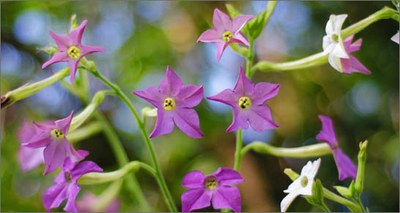Health: Biotech, from wild tobacco supermolecules for medicines and food
29/10/2020
 ENEA has developed an innovative, fast and low-cost biotechnological method to produce crocins, picrocrocins and safranal in large quantities. They are molecules beneficial to humans and of great interest for the food, cosmetic and pharmaceutical industries but very scarce in nature. The method is described in a study conducted jointly with the Institute of Molecular and Plant Cell Biology (IBMCP) of Valencia and the University of Castilla-La Mancha (UCLM) and published in the prestigious international journal "Metabolic Engineering".
ENEA has developed an innovative, fast and low-cost biotechnological method to produce crocins, picrocrocins and safranal in large quantities. They are molecules beneficial to humans and of great interest for the food, cosmetic and pharmaceutical industries but very scarce in nature. The method is described in a study conducted jointly with the Institute of Molecular and Plant Cell Biology (IBMCP) of Valencia and the University of Castilla-La Mancha (UCLM) and published in the prestigious international journal "Metabolic Engineering".
The antioxidant, analgesic, anti-inflammatory and preventive properties of these real 'super molecules', useful for the treatment of numerous pathologies such as degenerative diseases of the retina, some forms of cancer, senile dementia and depression, as well as as dyes, perfumes, flavors and food supplements, are of interest for the pharmaceutical industry..
The innovative system is based on a suitably "engineered" non-pathogenic plant virus introduced into wild tobacco plants (Nicotiana benthamiana): up to 2 mg of crocins and 8 mg of picrocrocin per gram ofdry weight of the leaf were obtained in just two weeks which increased, through further metabolic engineering experiments, to 3.8 mg of crocins.
"These quantities are almost 150 times higher than in previous studies and represent a very significant result considering that in nature these molecules - belonging to the group of apocarotenoids and responsible for the color, taste and aroma of saffron - are present, in fact , only in saffron which has poor yields and in buddleja, or 'butterfly plant', not suitable for food use” Gianfranco Diretto at the ENEA Biotechnology Laboratory explained.
"The use of Nicotiana benthamiana treated with this method therefore represents a valid and fast alternative to saffron and buddleja – Diretto said, pointing out that - these studies allow us to take a further step on the biotechnological exploitation of beneficial molecules for humans and open new scenarios on the fast and low cost production of crocins, in order to achieve a large-scale industrial and pharmaceutical use ".
As of today, saffron cultivation is limited to marginal lands, each plant yields a maximum of 3 flowers, each of which bears a maximum of 3 stigmas,. Crocins accumulate in the stigmas tissues, and harvesting and processing must be conducted manually. Moreover, saffron is a sterile plant, which makes genetic improvement more difficult. All this makes saffron the most expensive spice in the world, up to 15 thousand euro per kilo.
Buddleja davidii is a plant native to the mountain areas of China but cultivated in Europe since the end of the 19th century as an ornamental plant. It is characterized by flowers in whose corolla the crocins are produced and accumulated, and which constitute a beautiful and typical inflorescence, with colors ranging from white to pink / purple red to blue / purple, fragrant and rich in nectar, which attracts butterflies, hence the name "butterfly tree".
For more information please contact:
Gianfranco Diretto, ENEA – Biotechnologies Laboratory - gianfranco.diretto@enea.it
Jose Antonio Daros, (IBMCP) Institute for Plant Molecular and Cellular Biology- jadaros@ibmcp.upv.es
Lourdes Gomez-Gomez, Castilla-La Mancha University (UCLM); mariaLourdes.Gomez@uclm.es
Link to the article: https://www.sciencedirect.com/science/article/pii/S1096717620301087
